Banana Pi
Banana Pi is a line of low-cost credit card-sized single-board computers produced by the Chinese company Shenzhen SINOVOIP Co. Ltd. The hardware design of the Banana Pi computers was influenced by the Raspberry Pi.
Banana Pi is compatible with Raspberry Pi boards. Banana Pi also can run NetBSD, Android, Ubuntu, Debian, Arch Linux, Raspbian operating systems, though the CPU complies with the requirements of the Debian armhf port.[1] It uses the Allwinner SoC (system on chip) and as such is mostly covered by the linux-sunxi port.
Banana Pi is the open source hardware and software platform which is designed to assist banana-pi.org.
Banana Pi BPI-M1
 Banana Pi single board computer | |
| Developer | Banana Pi |
|---|---|
| Type | Single-board computer |
| Release date | April 2014 |
| Operating system | Android (Android 4.2, Android 4.4),Linux (Armbian, Bananian, Lubuntu, Raspbian, Debian GNU/Linux, Fedora, Arch Linux ARM, Gentoo, openSUSE), Berryboot, FreeBSD, OpenWrt |
| System-on-chip used | Allwinner A20[2] |
| CPU | ARM Cortex-A7 Dual-core (ARMv7-A) 1 GHz |
| Memory | 1 GB |
| Storage | SD card & SATA 2.0 |
| Graphics | Mali-400 MP2[3] |
| Dimensions | 92 mm × 60 mm |
| Weight | 48 g |
The Banana Pi BPI-M1 is a business card-sized and low-power single-board computer featuring a high performance AllWinner dual-core SoC at 1 GHz, 1GB of DDR3 SDRAM, Gigabit Ethernet, SATA, USB, and HDMI connections. It can run a variety of operating systems including Android, Lubuntu, Ubuntu, Debian, and Raspbian.
Key Features:
- Allwinner A20 Dual-core 1.0 GHz CPU
- Mali-400 MP2 with Open GL ES 2.0/1.1.
- 1 GB DDR3 memory.
- 1x SATA interface.
- 1x Gigabit LAN
- 1x USB otg and 2x USB 2.0
- 1X MIC
- AV vide out
- HDMI out
- IR
- CSI camera interface
- DSI display interface
- 26 PIN gpio
| Banana Pi BPI-M1 | |||
| CPU | A20 ARM Cortex -A7 Dual-Core | ||
| GPU | ARM Mali 400 MP2; Complies with OpenGL ES 2.0/1.1 | ||
| Memory | 1GB DDR3 | ||
| Network | 10/100/1000 Ethernet 8P8C (1000BASE-T) | ||
| Video Input | A CSI input connector allows for the connection of a designed camera module | ||
| Video Outputs | HDMI, CVBS, LVDS/RGB | ||
| Audio Outputs | 3.5mm jack and HDMI | ||
| Power Source | 5 volts DC via Micro USB or GPIO | ||
| USB 2.0 ports | 2 (direct from Allwinner A20 chip) | ||
| GPIO | GPIO, UART, I2C BUS, SPI BUS, WITH TWO CHIP SELECTS, CAN bus, ADC, PWM, +3.3V, +5V, GND | ||
| LED | Power Key & 8P8C | ||
| Storage | SATA 2.0, | ||
BPI official WIKI Banana Pi BPI-M1 wiki page
Neither Banana Pi nor Shenzhen SINOVOIP Co.,Ltd. have a direct relationship to the Raspberry Pi Foundation, though its similarities are clear.[4] "Linux User & Developer" does not consider it a "direct clone, but a considerable evolution," whilst linux.com similarly sees it as a clone with improved performance.[5][6] The board layout is very similar to the Raspberry Pi board, though it's about 10% larger and the relative spacing of some connectors varies. Not all Raspberry Pi accessories will fit as a result.
Banana Pi BPI-M1+
 Banana Pi single board computer | |
| Developer | Banana Pi |
|---|---|
| Type | Single-board computer |
| Release date | April 2015 |
| Operating system | Android (Android 4.2, Android 4.4),Linux (Bananian, Lubuntu, Raspbian, Debian GNU/Linux, Fedora, Arch Linux ARM, Gentoo, openSUSE), Berryboot, FreeBSD, OpenWrt |
| System-on-chip used | Allwinner A20[2] |
| CPU | ARM Cortex-A7 Dual-core (ARMv7-A) 1 GHz |
| Memory | 1 GB |
| Storage | MicroSD card & SATA 2.0 |
| Graphics | Mali-400 MP2[3] |
| Dimensions | 92 mm × 60 mm |
| Weight | 48 g |
The Banana BPI-M1+ is a credit-card-sized and low-power single-board computer.
| Banana Pi BPI-M1+ | |||
| CPU | A20 ARM Cortex -A7 Dual-Core | ||
| GPU | ARM Mali400MP2Complies with OpenGL ES 2.0/1.1 | ||
| Memory | 1GB DDR3 | ||
| Network | 10/100/1000 Ethernet | ||
| wifi&BT | Wifi & BT 4.0 support onboard | ||
| Video Input | A CSI input connector allows for the connection of a designed camera module | ||
| Video Outputs | HDMI, CVBS, LVDS/RGB | ||
| Audio Outputs | 3.5mm jack and HDMI | ||
| Power Source | 5V/2A via Micro USB (DC in only) and / or Micro USB OTG | ||
| USB 2.0 ports | 2(direct from Allwinner A20 chip) | ||
| GPIO | GPIO, UART, I2C BUS, SPI BUS, WITH TWO CHIP SELECTS, CAN bus, ADC, PWM, +3.3V, +5V, GND | ||
| LED | Power Key & 8P8C | ||
| Storage | SATA 2.0 | ||
| OS | Android 4.4, Android 4.2, Raspbian, Lubuntu, Open Suse, Debian | ||
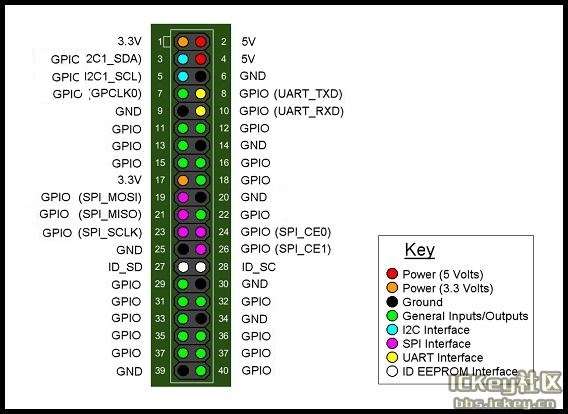
Note:
- The Banana Pi M1+ (Plus) Board BPI wiki page Banana Pi BPI-M1+ (Plus) wiki Page
Banana Pi BPI-M2+(BPI-M2 Plus)
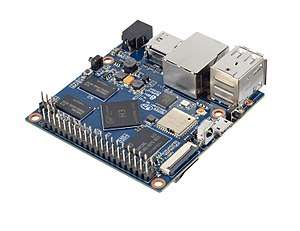 Banana Pi BPI-M2+ single board computer | |
| Type | Single-board computer |
|---|---|
| Release date | April 2016 |
| Operating system | Android (4.2, 4.4),Linux (Bananian, Lubuntu, Raspbian, Debian GNU/Linux, Fedora, Arch Linux ARM, Gentoo, openSUSE), Berryboot, FreeBSD |
| System-on-chip used | Allwinner H3[7] |
| CPU | ARM Cortex-A7 Quad-core (ARMv7-A) 1 GHz (Cache: 256kB L1, 1MB L2) |
| Memory | 1 GB (shared with GPU) |
| Storage | MicroSD |
| Graphics | Mali 400MP2 @ 600 MHz, OpenGL ES 2.0 |
| Sound | HDMI out |
| Camera | CSI input camera module |
| Connectivity | 2× USB 2.0 (3.3V or 5V), HDMI out, 10/100/1000 Mbps Ethernet, AP6212 Wi-Fi Module |
| Power | 5 V DV via Micro USB and Micro USB OTG |
| Dimensions | 65 mm × 65 mm |
| Weight | 48 g |
The Banana PI BPI-M2+ was released in April 2016. It sports an Allwinner H3 SoC with a quad-core CPU and an on-board WiFi module.
It runs Android, Debian, Ubuntu, and Raspbian images for the Raspberry Pi. Banana Pi PBI-M2 hardware: 1Ghz ARM7 quad-core processor, 1GB DDR3 SDRAM, 8GB eMMC flash on board, and SDIO wifi module on board.
| Banana Pi BPI-M2+ (BPI-M2 Plus) | |||
| CPU | H3 Quad-core Cortex-A7 H.265/HEVC 4K | ||
| GPU | Mali400MP2 GPU @600 MHz,Supports OpenGL ES 2.0 | ||
| Memory | 1GB DDR3 (shared with GPU) | ||
| Onboard Network | 10/100/1000 Ethernet | ||
| Onboard WIFI | SDIO AP6212(option AP6181 AP6335) | ||
| Video Input | A CSI input connector Camera:1 Supports 8-bit YUV422 CMOS sensor interface,2 Supports CCIR656 protocol for NTSC and PAL, 3 Supports SM pixel camera sensor, 4 Supports video capture solution up to 1080p@30fps | ||
| Video Outputs | Supports HDMI output with HDCP, Supports HDMI CEC, Supports HDMI 30 function, Integrated CVBS, Supports simultaneous output of HDMI and CVBS | ||
| Audio Outputs | HDMI | ||
| Power Source | DC input can supply power, but USB OTG input don’t supply power | ||
| USB 2.0 ports | two USB 2.0 HOST, one USB 2.0 OTG | ||
| GPIO | 40 Pins Header,compatible with Raspberry Pi B+ | ||
| LED | Power led & Status led | ||
| IR | IR input on board | ||
| OS | Android, Ubuntu, Debian, Raspberry Pi Image | ||
Note:
- The Banana Pi M2+ (Plus) Board BPI wiki page Banana Pi M2+ (Plus) wiki Page
Banana Pi BPI-M2 Zero
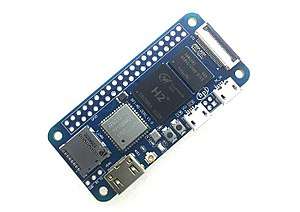 Banana Pi BPI-M2 Zero single board computer | |
| Developer | Banana Pi |
|---|---|
| Type | Single-board computer |
| Release date | July 2017 |
| Operating system | Android (Android 4.2, Android 4.4),Linux (Armbian, Bananian, Lubuntu, Raspbian, Debian GNU/Linux, Fedora, Arch Linux ARM, Gentoo, openSUSE), Berryboot, FreeBSD, OpenWrt |
| System-on-chip used | Allwinner H2+ [8] |
| CPU | ARM Cortex-A7 quad-core (ARMv7-A) 1 GHz |
| Memory | 512M |
| Storage | SD card |
| Graphics | Mali-400 MP2[3] |
| Dimensions | 65 mm × 30 mm |
| Weight | 48 g |
The Banana Pi BPI-M2 Zero is a low-power single-board computer featuring a high performance AllWinner quad-core SoC at 1.2 GHz, 512M of DDR3 SDRAM, USB, WiFi, Bluetooth and mini HDMI.
BPI-M2 Zero is same size as Raspberry pi Zero W, so can use Raspberry pi Zero W case .
Key Features
- CPU: Allwinner H2+, Quad-core Cortex-A7.
- 512MB DDR 3 SDRAM.
- WiFi (AP6212) & Bluetooth on board.
- Mini HDMI.
- 40 PIN GPIO,It includes UART, SPI, I2C, IO etc.
| HardWare Specification of Banana pi BPI-M2 Zero | |||
| CPU | H2+ ARM Cortex -A7 quad-Core | ||
| GPU | ARM Mali 400 MP2; Complies with OpenGL ES 2.0/1.1 | ||
| Memory | 512MB DDR3 | ||
| Network | WIFI 802.11 b/g/n, 10/100 Ethernet | ||
| Video Outputs | HDMI, MIPI | ||
| Audio Outputs | HDMI | ||
| Power Source | 5 volts DC via Micro USB or GPIO | ||
| USB 2.0 ports | 1 (direct from Allwinner H2+ chip) | ||
| GPIO | GPIO, UART, I2C BUS, SPI BUS, WITH TWO CHIP SELECTS, CAN bus, ADC, PWM, +3.3V, +5V, GND | ||
| LED | Power Key & 8P8C | ||
| Storage | SD slots | ||
The Banana Pi has the same GPIO headers as the Raspberry Pi 1 Model A & B, as seen below.
- The Banana Pi BPI-M2 Zero Board BPI wiki page Banana Pi BPI-M2 Zero wiki Page
Banana Pi BPI-P2 Zero
 Banana Pi BPI-P2 Zero single board computer | |
| Developer | Banana Pi |
|---|---|
| Type | Single-board computer |
| Release date | July 2018 |
| Operating system | Android (Android 4.2, Android 4.4),Linux (Armbian, Bananian, Lubuntu, Raspbian, Debian GNU/Linux, Fedora, Arch Linux ARM, Gentoo, openSUSE), Berryboot, FreeBSD, OpenWrt |
| System-on-chip used | Allwinner H2+ [8] |
| CPU | ARM Cortex-A7 quad-core (ARMv7-A) 1 GHz |
| Memory | 512M |
| Storage | SD card |
| Graphics | Mali-400 MP2[3] |
| Dimensions | 65 mm × 52.5 mm |
| Weight | 48 g |
The Banana Pi BPI-P2 Zero is a low-power single-board computer featuring a high performance AllWinner quad-core SoC at 1.2 GHz, 512M of DDR3 SDRAM, USB, WiFi, Bluetooth and mini HDMI.
Key Features
- CPU: Allwinner H2+, Quad-core Cortex-A7.
- 512MB DDR 3 SDRAM.
- WiFi (AP6212) & Bluetooth on board.
- Mini HDMI.
- 40 PIN GPIO,It includes UART, SPI, I2C, IO etc.
- 100M LAN
- IEEE 802.3af PoE standard PoE module support
- 8G eMMC flash on board.
BPI-P2 Zero, just 3 change on BPI-M2 Zero . other hadware design same as BPI-M2 Zero.so all software is same .
- 1,add 8G eMMC flash support on board, easy to do IoT gateway.
- 2,BPI-P2 Zero with 100M LAN interface, BPI-M2 Zero with PIN define for 100M lan, use way is same.
- 3,PoE function support on board.
| HardWare Specification of Banana pi BPI-P2 Zero | |||
| CPU | Allwinner H2+ ARM Cortex -A7 quad-Core (Option H3/H5) | ||
| GPU | ARM Mali 400 MP2; Complies with OpenGL ES 2.0/1.1 | ||
| Memory | 512MB DDR3 | ||
| eMMC flash | 8G eMMC 5.1 falsh | ||
| WIFI | WIFI 802.11 b/g/n, 10/100 Ethernet | ||
| BT | BT4.0 | ||
| Network | 1x10/100 Ethernet | ||
| PoE | IEEE 802.3af PoE module | ||
| Video Outputs | HDMI, MIPI | ||
| Audio Outputs | HDMI | ||
| Power Source | 5 volts DC via Micro USB or GPIO | ||
| USB 2.0 ports | 1 (direct from Allwinner H2+ chip) | ||
| GPIO | GPIO, UART, I2C BUS, SPI BUS, WITH TWO CHIP SELECTS, CAN bus, ADC, PWM, +3.3V, +5V, GND | ||
| LED | Power Key & 8P8C | ||
| Storage | SD slots | ||
- The Banana Pi BPI-P2 Zero Board BPI wiki page Banana Pi BPI-P2 Zero wiki Page
- BPI-P2 Zero PoE module wiki :BPI-9600 IEEE 802.3af PoE module
Banana Pi BPI-M2 Ultra
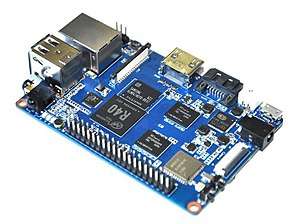 Banana PI BPI-M2 Ultra single board computer | |
| Developer | Banana Pi |
|---|---|
| Type | Single-board computer |
| Release date | November 2016 |
| Operating system | Android (Android 5.1.1),Linux (Bananian, Lubuntu, Raspbian, Debian GNU/Linux, Fedora, Arch Linux ARM, Gentoo, openSUSE), Berryboot, FreeBSD, OpenWrt |
| System-on-chip used | Allwinner R40[9] |
| CPU | ARM Cortex-A7 Quad-core (ARMv7-A) 2 GHz |
| Memory | 2 GB |
| Storage | MicroSD card & 8GB eMMC & support SATA interface |
| Graphics | Mali400 MP2 |
| Dimensions | 92 mm × 60 mm |
| Weight | 45 g |
Banana PI BPI-M2 Ultra (BPI-M2U) is an open source hardware platform, it uses Allwinner R40 system-on-chip, it supports WIFI+BT on board, and supports SATA interface on board.
Banana PI PBI-M2 Ultra hardware: Quad Core ARM Cortex A7, ARMv7 CPU, 2GB DDR3 SDRAM, 8G eMMC flash on board, Gigabit Ethernet port, built-in 3.7V Li-ion battery charging circuit.
It can run Android smoothly, it supports 1080P video, and the 40 pin GPIO header is pin-compatible with the Raspberry Pi.
| HardWare Specification of Banana pi BPI-M2 Ultra | |||
| Soc | Allwinner R40/V40 | ||
| CPU | quad-core cortex -A7,the most power efficient CPU core ARM's ever development | ||
| GPU | dual-core MALI-400 MP2 and runs at 500 MHz, capable of 1.1 Gpixel/s throughput. Graphics capabilities are slightly higher than the original Xbox’s level of performance. The GPU provides OpenGL ES 2.0, hardware-accelerated OpenVG, 1080p45 H.264 high-profile encode and decode. | ||
| SDRAM | 2 GB DDR3 with 733 MHz\(shared with GPU\) | ||
| SATA | suppoort SATA interface | ||
| GPIO | 40 Pins Header, 28×GPIO, some of which can be used for specific functions including UART, I2C, SPI, PWM, I2S. | ||
| On board Network | 10/100/1000Mbit/s Ethernet \(Realtek RTL8211E/D\) | ||
| Wifi Module | WiFi 802.11 b/g/n \(AP 6212 module on board\) | ||
| Bluetooth | BT4.0 | ||
| On board Storage | MicroSD \(TF\) card,8GB eMMC onboard | ||
| Display | 4-lane MIPI DSI display,or RGB panel or LVDS panel,TV-out on HDMI V1.4 | ||
| Video | Multi-format FHD video decoding, including Mpeg1/2, Mpeg4, H.263, H.264, etc. H.264 decode up to 1080P60,support video encodeing:High-deinition\(HD\)H.264 video encoder is up to 1080P@45fps | ||
| Audio outputs | HDMI, analog audio \(via 3.5 mm TRRS jack\) | ||
| Camera | A CSI input connector Camera:Supports 8-bit YUV422 CMOS sensor interface,Supports CCIR656 protocol for NTSC and PAL,Supports 5M pixel camera sensor, Supports video capture solution up to 1080p@30fps | ||
| Audio input | On board microphone | ||
| USB | 2 USB 2.0 host, 1 USB 2.0 OTG | ||
| Buttons | Reset button, Power button, U-boot button | ||
| Leds | Power status Led and RJ45 Led | ||
| IR | onboard IR receiver | ||
| DC Power | 5V/2A with micro USB port | ||
| battery | 3.7V lithium battery power support | ||
| Sizes | 85mmX56mm,same size as raspberry pi 3 | ||
| Weight | 40g | ||
Note:
- The Banana Pi M2 Ultra Board BPI wiki page Banana Pi M2 (Ultra) wiki Page
- using a 3.5" HDD may require external power source for the disk; on-board power can not provide enough current.
Banana Pi BPI-M2 Berry
 Banana Pi-M2 single board computer | |
| Type | Single-board computer |
|---|---|
| Release date | May 2017 |
| Operating system | Android (Android 5.1.1, Android 6.0),Linux (Bananian, Lubuntu, Raspbian, Debian GNU/Linux, Fedora, Arch Linux ARM, Gentoo, openSUSE), Berryboot, FreeBSD |
| System-on-chip used | Allwinner V40 |
| CPU | ARM Cortex-A7 Quad-core (ARMv7-A) 1.2 GHz |
| Memory | 1 GB |
| Storage | MicroSD card & SATA |
| Graphics | Mali400MP2 GPU |
| Connectivity | 10/100/1000 Mbps Ethernet, Wi-Fi 802.11 b/g/n (AP module on board), BT 4.0 |
| Dimensions | 92 mm × 60 mm |
| Weight | 45 g |
Banana PI BPI-M2 Berry (BPI-M2B) is an open source hardware platform, it uses Allwinner V40 system-on-chip and it supports Wi-Fi and Bluetooth on board.[10]
Banana PI M2 Berry hardware: 64 Bit Quad Core ARM Cortex A7 1.2 GHz CPU, 1GB DDR3 SDRAM, No eMMC, Gigabit Ethernet port.
Banana PI M2 Berry series can run Android, Debian, Ubuntu, Raspbian and other OS. It can run Android smoothly when resolution is under HD or GPU is not needed.
Since R40 and V40 chips are pin-to-pin compatible, they can be swapped in BPI-M2 Ultra and BPI-M2 Berry versions resulting in two hybrid products.
| HardWare Specification of Banana pi BPI-M2 Berry | |||
| Soc | Allwinner R40/V40 | ||
| CPU | quad-core cortex -A7,the most power efficient CPU core ARM's ever development | ||
| GPU | dual-core MALI-400 MP2 and runs at 500 MHz, capable of 1.1 Gpixel/s throughput. Graphics capabilities are slightly higher than the original Xbox’s level of performance. The GPU provides OpenGL ES 2.0, hardware-accelerated OpenVG, 1080p45 H.264 high-profile encode and decode. | ||
| SDRAM | 1GB DDR3 with 733 MHz\(shared with GPU\) | ||
| SATA | suppoort SATA interface | ||
| GPIO | 40 Pins Header, 28×GPIO, some of which can be used for specific functions including UART, I2C, SPI, PWM, I2S. | ||
| On board Network | 10/100/1000Mbit/s Ethernet \(Realtek RTL8211E/D\) | ||
| Wifi Module | WiFi 802.11 b/g/n \(AP 6212 module on board\) | ||
| Bluetooth | BT4.0 | ||
| On board Storage | MicroSD \(TF\) card,No eMMC onboard | ||
| Display | 4-lane MIPI DSI display,or RGB panel or LVDS panel,TV-out on HDMI V1.4 | ||
| Video | Multi-format FHD video decoding, including Mpeg1/2, Mpeg4, H.263, H.264, etc. H.264 decode up to 1080P60,support video encodeing:High-deinition\(HD\)H.264 video encoder is up to 1080P@45fps | ||
| Audio outputs | HDMI, analog audio \(via 3.5 mm TRRS jack\), I2S audio \(also potentially for audio input\) | ||
| Camera | A CSI input connector Camera:Supports 8-bit YUV422 CMOS sensor interface,Supports CCIR656 protocol for NTSC and PAL,Supports 5M pixel camera sensor, Supports video capture solution up to 1080p@30fps | ||
| Audio input | On board microphone | ||
| USB | 4 USB 2.0 host, 1 USB 2.0 OTG | ||
| Buttons | Reset button, Power button, U-boot button | ||
| Leds | Power status Led and RJ45 Led | ||
| IR | No onboard IR receiver | ||
| DC Power | 5V/2A with micro USB port | ||
| battery | No 3.7V lithium battery power support | ||
| Sizes | 85mmX56mm,same size as raspberry pi 3 | ||
| Weight | 40g | ||
Note:
- The Banana Pi M2 (Berry) Board BPI wiki page:Banana Pi M2 (Berry) wiki Page
Banana Pi BPI-M2 Magic
 Banana Pi-M2 Magic single board computer | |
| Developer | Banana Pi |
|---|---|
| Type | Single-board computer |
| Release date | November 2017 |
| Operating system | Android (Android 5.1.1),Linux (Bananian, Lubuntu, Raspbian, Debian GNU/Linux, Fedora, Arch Linux ARM, Gentoo, openSUSE), Berryboot, FreeBSD, OpenWrt |
| System-on-chip used | Allwinner R16[11] |
| CPU | ARM Cortex-A7 Quad-core (ARMv7-A) 2 GHz |
| Memory | 512 MB |
| Storage | MicroSD card & 8GB eMMC |
| Graphics | Mali400 MP2 |
| Dimensions | 51 mm × 51 mm |
| Weight | 45 g |
Banana PI BPI-M2 Magic (BPI-M2M) is an efficient quad core solution designed for internet-of-things applications,Use allwinner R16 chip design, also can use Allwinner A33 chip on board, which outperforms competitors in terms of its system performance, scalability, and energy-efficiency; it can be used for home entertainment, home automation, and high wireless performance, etc.
| Banana Pi M2 Magic | |
|---|---|
| CPU | Allwinner R16 ARM Cortex-A7 Quad-Core |
| GPU | PowerVR SGX544MP1 Comply with OpenGL ES 2.0 OpenCL 1x, DX9_3 |
| Memory | 512MB LPDDR3 (shared with GPU) |
| Storage | On Board 8GB eMMC Flash, Micro SD-Card slot. |
| Network | Wi-Fi 802.11 b/g/n (AP6212) + Bluetooth BT4.0 |
| Video Input(s) | A CSI input connector allows for the connection of a designed camera module |
| Video Output(s) | MIPI Display Serial Interface (DSI) for raw LCD Panel |
| Audio Input(s) | On board microphone |
| Audio Output(s) | 3.5mm jack |
| USB ports | USB 2.0 PORT (x1), USB OTG (x1) |
| Remote | Not IR Receiver |
| GPIO | 40 Pin Header : GPIO (x28) and Power (+5V, +3.3V and GND). Some of I/O Pin can be used for specific functions as UART, I2C, SPI or PWM |
| Switches | Reset, Power and U-boot |
| LED | Power Status and 8P8C |
| Power Source | 5 volt @2A via DC Power and/or Micro USB (OTG) |
| Size & Weight | 51x51mm, 48g |
| OS | Android and Linux |
Note:
- 1. BPI-M2 Magic not HDMI interface.
- 2. Not support RJ45 interface.
- The Banana Pi M2 (Magic) Board BPI wiki: Banana Pi BPI-M2 Magic wiki Page
Banana Pi BPI-M3
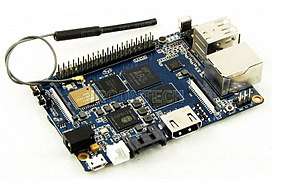 Banana Pi-M3 single board computer | |
| Developer | Banana Pi |
|---|---|
| Type | Single-board computer |
| Release date | November 2015 |
| Operating system | Android (Android 5.1.1),Linux (Bananian, Lubuntu, Raspbian, Debian GNU/Linux, Fedora, Arch Linux ARM, Gentoo, openSUSE), Berryboot, FreeBSD, OpenWrt |
| System-on-chip used | Allwinner A83t[12] |
| CPU | ARM Cortex-A7 Octa-core (ARMv7-A) 2 GHz |
| Memory | 2 GB |
| Storage | MicroSD card & 8GB eMMC & SATA 2.0[13] |
| Graphics | Power VR SGX544MP1 |
| Dimensions | 92 mm × 60 mm |
| Weight | 48 g |
Banana Pi M3 is an open source hardware platform, it is an octa-core version of Banana Pi, it supports onboard Wi-Fi and SATA Port. Banana Pi M3 is able to run Android 5.1.1, Debian, Ubuntu, Raspberry Pi and other OS.
Banana PI M3 hardware: 2Ghz ARM7 octa-core processor, 2GB LPDDR3 SDRAM, Gigabit ethernet port and the GPIO is compatible with Raspberry Pi B+.
| Banana Pi M3 | |
|---|---|
| CPU | Allwinner A83T ARM Cortex-A7 Octa-Core 1.8 GHz, 512KB L1 cache and 1MB L2 cache |
| GPU | PowerVR SGX544MP1 Comply with OpenGL ES 2.0 OpenCL 1x, DX9_3 |
| Memory | 2GB LPDDR3 (shared with GPU) |
| Storage | On Board 8GB eMMC Flash, Micro SD-Card slot, SATA 2.0 Port (USB-to-SATA bridge)[13] |
| Network | 10/100/1000 Mbit/s Ethernet (Realtek RTL8211E/D) + Wi-Fi 802.11 b/g/n (AP6212) + Bluetooth BT4.0 |
| Video Input(s) | A CSI input connector allows for the connection of a designed camera module |
| Video Output(s) | HDMI 1.4 (Type A Full), MIPI Display Serial Interface (DSI) for raw LCD Panel |
| Audio Input(s) | On board microphone |
| Audio Output(s) | 3.5mm jack and HDMI |
| USB ports | USB 2.0 PORT (x2), USB OTG (x1) |
| Remote | IR Receiver (x1) |
| GPIO | 40 Pin Header : GPIO (x28) and Power (+5V, +3.3V and GND). Some of I/O Pin can be used for specific functions as UART, I2C, SPI or PWM |
| Switches | Reset, Power and U-boot |
| LED | Power Status and 8P8C |
| Power Source | 5 volt @2A via DC Power and/or Micro USB (OTG) |
| Size & Weight | 92x60mm, 48g |
| OS | Android and Linux |
Note:
- The Banana Pi M3 Board BPI wiki page: Banana Pi M3 wiki Page
- The Banana Pi M3 Board detailed document on Banana Pi M3 Gitbook Page
Banana Pi BPI-M64
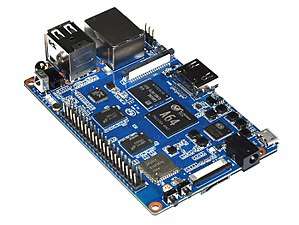 Banana Pi-M64 single board computer | |
| Type | Single-board computer |
|---|---|
| Release date | November 2016 |
| Operating system | Android (Android 5.1.1, Android 6.0),Linux (Bananian, Lubuntu, Raspbian, Debian GNU/Linux, Fedora, Arch Linux ARM, Gentoo, openSUSE), Berryboot, FreeBSD |
| System-on-chip used | Allwinner A64 |
| CPU | ARM Cortex-A53 Quad-core (ARMv8-A) 1.2 GHz |
| Memory | 2 GB |
| Storage | MicroSD card & 8GB eMMC |
| Graphics | Mali450MP4 GPU |
| Dimensions | 92 mm × 60 mm |
| Weight | 48 g |
| HardWare Specification of Banana pi BPI-M64 | |||
| CPU | Allwinner 64 Bit Quad Core ARM Cortex A53 1.2 GHz CPU | ||
| GPU | Dual core Mali 400 MP2 GPU | ||
| Memory | 2GB LPDDR3 (shared with GPU) | ||
| Storage | MicroSD slot with support for up to 256GB expansion and 8G eMMC flash with support for up to 64GB | ||
| Network | 10/100/1000 Mbit/s Ethernet + Wi-Fi 802.11 b/g/n + Bluetooth 4.0 | ||
| Video Input(s) | A CSI input connector allows for the connection of a designed camera module | ||
| Video Output(s) | 1080p capable HDMI port and multi-channel audio output (NO H./X.265 capabilities) | ||
| Audio Input(s) | On board microphone | ||
| Audio Output(s) | 3.5mm jack and HDMI | ||
| USB ports | USB 2.0 PORT (x2), USB OTG (x1) | ||
| Remote | IR Receiver | ||
| GPIO | 40 Pin Header : GPIO (x28) and Power (+5V, +3.3V and GND). GPIO pins can be used for UART, I2C, SPI or PWM | ||
| Switches | Reset, Power and U-boot | ||
| LED | Power Status and 8P8C | ||
| Power Source | 5 volt @2A via DC Power and/or Micro USB (OTG) | ||
| Size & Weight | 92x60mm, 48g | ||
| OS | Android and Linux | ||
Note:
- The Banana Pi M64 Board BPI wiki page : Banana Pi M64 wiki Page
Banana Pi BPI-F2
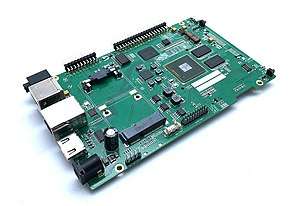 Banana Pi BPI-F2 | |
| Type | Single-board computer |
|---|---|
| Release date | 20180801 |
| Operating system | Android,Linux, OpenWrt and others |
| System-on-chip used | freescale IMX6 |
| CPU | ARM Cortex-A9 MPCore 4xCPU processor(with TrustZone) |
| Memory | 2 GB |
| Storage | 8GB eMMC |
| Graphics | OpenGL ES 2.0 |
| Weight | 100 g |
Banana Pi BPI-F2 use freescale IMX6 Industrial chip design. IMX6 with ARM Cortex-A9 MPCore 4xCPU processor(with TrustZone),this is ths first banana pi board design with freescale chip.
| HardWare Specification of Banana pi BPI-F2 | |||
| Soc | freescale IMX6 | ||
| CPU | ARM Cortex-A9 MPCore 4xCPU processor(with TrustZone) | ||
| GPU | OpenGL ES 2.0 3D graphics accelerator with forshaders,2D graphics accelerator,and didicated OpenVG 1.1 accelerator | ||
| SDRAM | 2G DDR3 | ||
| PCIE | 1 mini PCIE interface | ||
| CAN bus | 1 CAN bus interface | ||
| SATA | support 1*SATA interface | ||
| GPIO | 40 Pins Header, 28×GPIO, some of which can be used for specific functions including UART, I2C, SPI, PWM, I2S. | ||
| On board Network | 10/100/1000 Mbit/s Ethernet | ||
| Wifi Module | N/A | ||
| Bluetooth | N/A | ||
| On board Storage | MicroSD \(TF\) card,8G eMMC onboard (option 8-64G) | ||
| Display | HDMI out, LVDS out | ||
| Video | HDMI out, LVDS out | ||
| Audio outputs | 1 * 3.5 headset jack | ||
| Camera | 1 * DVP camera interface and 1* MIP camera interface | ||
| Audio input | N/A | ||
| USB | 2 * USB 2.0 1* USB Otg | ||
| Buttons | Power & Reset | ||
| Leds | 3* RGB leds | ||
| IR | N/A | ||
| DC Power | 12V/2A with DC port | ||
| battery | No 3.7V lithium battery power support | ||
| Sizes | |||
| Weight | 80g | ||
Note:
- The Banana Pi BPI-F2 BPI wiki page : Banana Pi BPI-F2 wiki Page
Banana Pi BPI-S64 core
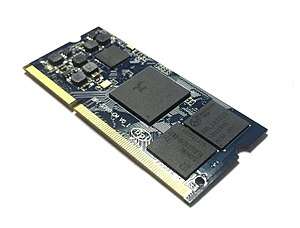 Banana Pi-S64 core compute module | |
| Type | Single-board computer |
|---|---|
| Release date | 20180601 |
| Operating system | Android (Android 5.1.1), Linux (Lubuntu, Raspbian, Debian GNU/Linux) |
| System-on-chip used | Actions S700 |
| CPU | ARM Cortex-A53 Quad-core |
| Memory | 2 GB |
| Storage | 8GB eMMC |
| Graphics | Mali400MP2 GPU |
| Dimensions | 67.5 mm × 30 mm |
| Weight | 50 g |
Banana Pi BPI-S64 core use Actions SOC S700 design. S700 chip with ARM Cortex-A53 Quad-Core CPU,Mali450 MP4 GPU. BPI-S64 core with 2G LPDDR3 and 8G eMMC flash on board.
BPI-S64 core modules are small enough to fit all kinds of hardware.In addition,S64 core also provides I/O boards with GPIO ports, as well as USB, MicroUSB, CSI, DSI, HDMI, and MicroSD and other many interfaces.
| Banana Pi BPI-S64 core | |
|---|---|
| CPU | Actions S700 64 Bit Quad Core ARM Cortex A53 CPU |
| GPU | Dual core Mali 450 MP4 GPU |
| Memory | 2GB LPDDR3 (shared with GPU) |
| Flash | 8GB eMMC flash |
| interfac | SODIMM-DDR3,204 PIN, all S700 GPIO support |
| Size | 67.5 x 30 mm |
- BPI-S64 core development kit spec
| HardWare Specification of Banana pi BPI-S64 core kit | |||
| CPU | Actions SOC S700,ARM Cortex-A53 Quad-Core CPU,Mali450 MP4 GPU | ||
| GPU | Mali450 MP4 GPU, OpenGL ES2.0/1.1 OpenVG 1.1 EGL 1.5 | ||
| Memory | 2GB LPDDR3 | ||
| Storage | 8GB eMMC | ||
| Power | 12V @ 2A via DC power | ||
| Low-level peripherals | 26 Pins Header, 28×GPIO, some of which can be used for specific functions including UART, I2C, SPI, PWM, I2S. | ||
| Onboard Network | 1 x 10/100/1000Mbit/s Ethernet | ||
| Wifi/Bluetooth | AP6212 WiFi and BT 4.0 | ||
| On board Storage | MicroSD \(TF\) card; 8G eMMC;SIM card slot | ||
| Display | HDMI \(Type A\) output with HDCP 1.4, resolutions up 1920x1200; MIPI DP ;LVDS | ||
| Video decoder/encode | support Real-time vide decode of most popular vide formats, such as MPEG-4,H.264,H.265. support video encoder for baseline H.264 | ||
| Audio | support two audio device HDMI and headphone, also support Audio In/Out with PIN define. support 1 MIC in | ||
| HDMI Out/In | 1* HDMI 1.4 | ||
| Audio outputs/Inputs | HDMI, I2S audio,Audio micro out | ||
| 4G | USB standard 4G LTE interface | ||
| USB 3.0 | 1x USB 3.0 host | ||
| USB 2.0 | 1x USB 2.0 OTG, 1 x USB port | ||
| Display | 1* Mini DP, 1* LVDS lcd, | ||
| Camera | 1 x DVP camera interface, 1 x MIPI interface | ||
| RTC battery | RTC battery power interface | ||
| battery | 3.7V battery interface. | ||
| Buttons | Reset button, Power button, ADC button | ||
| Leds | Red, Green, Blue | ||
| Other | IR receiver | ||
| Sizes | |||
| Power | DC 5V/2A | ||
| Weight | 150g | ||
Note:
- The Banana Pi S64 core Board BPI wiki page : Banana Pi S64 core wiki Page
Banana Pi BPI-R1
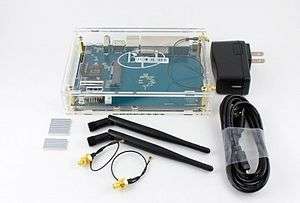 Banana Pi single board computer | |
| Developer | Banana Pi |
|---|---|
| Type | Single-board computer |
| Release date | October 2014 |
| Operating system | Android (Android 4.2, Android 4.4),Linux (Bananian, Lubuntu, Raspbian, Debian GNU/Linux, Fedora, Arch Linux ARM, Gentoo, openSUSE), Berryboot, FreeBSD, OpenWrt |
| System-on-chip used | Allwinner A20[8] |
| CPU | ARM Cortex-A7 Dual-core (ARMv7-A) 1 GHz |
| Memory | 1 GB |
| Storage | MicroSD card & SATA 2.0 |
| Graphics | Mali-400 MP2[3] |
The Banana Pi R1 is a 300Mbit/s Wireless N Router with both wired and wireless network connections is designed specifically for smart home networking use. With 2T2R MIMO technology and two detachable antennas, the R1 is a dual core system that runs smoothly with Android 4.2.2 and has a Gigabit ethernet port, SATA socket, supports games and 1080P high definition video output.
| Banana Pi R1 | |
|---|---|
| CPU | A20 ARM Cortex -A7 Dual-Core |
| GPU | ARM Mali400MP2Complies with OpenGL ES 2.0/1.1 |
| Memory | 1GB DDR3 |
| Network | 10/100/1000 Ethernet 8P8C, Wi-Fi |
| Video Input | A CSI input connector allows for the connection of a designed camera module |
| Video Outputs | HDMI, CVBS, LVDS/RGB |
| Audio Outputs | 3.5mm jack and HDMI |
| Power Source | 5 volt via Micro USB (DC in only) and / or Micro USB OTG |
| USB 2.0 ports | 2(direct from Allwinner A20 chip) |
| GPIO | GPIO, UART, I2C BUS, SPI BUS, WITH TWO CHIP SELECTS, CAN bus, ADC, PWM, +3.3V, +5V, GND |
| LED | Power Key & 8P8C |
| Storage | SATA 2.0 |
| OS | Android 4.4, Android 4.2, Raspbian, Lubuntu, Open Suse, Debian |
Note:
- The Banana Pi R1 Board BPI wiki page: Banana Pi R1 wiki Page
- The Banana Pi R1 Board detailed document on Banana Pi R1 Gitbook Page
 BPI-R1
BPI-R1 BPI-R1
BPI-R1
Banana Pi BPI-R2
 | |
| Developer | [ Banana Pi] |
|---|---|
| Type | Single-board computer |
| Release date | 2017 |
| Operating system | Android Android 5.1,Linux, OpenWrt and others |
| System-on-chip used | MediaTek MT7623N |
| CPU | ARM Cortex-A7 Quad-core (ARMv7-A) up to 1.3 GHz |
| Memory | 2 GB |
| Storage | eMMC, MicroSD card & SATA 3.0 (6Gbps, 1 or optionally 2 ports) |
| Graphics | Mali-450 MP4[3] |
| Dimensions | 148 mm × 100.5 mm |
| Weight | 100 g |
Banana PI BPI-R2 is a highly integrated multimedia network router; it can be used for high wireless performance, home entertainment, home automation, etc. BPI-R2 integrates a Quad-code ARM Cortex-A7 MPcore operating up to 1.3 GHz, The Router also includes a variety of peripherals, including HDMI TX, MIPI DSI, PCIe2.0, USB2.0 OTG, USB3.0 Port, SATA port,5 Gbit/s Port Gigabit Ethernet port, 802.11a/b/g/n wifi & BT4.1 on board, also support 802.11ac/n WLAN connection through mini PCI-e port BPI-R2can run with Android 5.1 smoothly, while as of the time of this entry this board does not work properly with any known linux distribution. The size of Banana PIBPI-R2 same as BPI-R1, it can easily run with games as it supports 1080P high definition video output,
| Banana Pi R2 | |
|---|---|
| CPU | MediaTek MT7623N, Quad-code ARM Cortex-A7 |
| GPU | Mali 450 MP4 GPU |
| Memory | 2G DDR3 SDRAM |
| Storage | On Board 8GB eMMC Flash, Micro SD-Card slot, Two SATA 2.0 Port (USB-to-SATA bridge) |
| Network | 10/100/1000 Mbit/s Ethernet (MT7530) + Wi-Fi 802.11 b/g/n 2.4G/5G (MT6625L) + Bluetooth BT4.1 with MTK6625L chip |
| Display(s) | HDMI (Type A) output with HDCP 1.4, resolutions up 1920x1200; MIPI Display Serial Interface (DSI) interface(4 data lanes) |
| Video decoder(s) | Multi-format FHD video decoding, including Mpeg1/2, Mpeg4, H.263, H.264, etc. H.264 high-profile 1080p@60fps, HEVC/H.265 1080P@60fps |
| Audio Output(s) | HDMI & I2S |
| USB ports | USB 3.0 PORT (x2), USB OTG (x1) |
| PCIE | 1 pcie interface & 1 pcie pin define interface |
| Remote | IR Receiver (x1) |
| GPIO | 40 Pin Header : GPIO (x28) and Power (+5V, +3.3V and GND). Some of I/O Pin can be used for specific functions as UART, I2C, SPI or PWM |
| Switches | Reset button, Power button, U-boot button |
| LED | Power Status and 8P8C |
| Power Source | 5 volt @2A via DC Power and/or Micro USB (OTG) |
| Size & Weight | 148 mm × 100.5mm 100g |
| OS | OpenWRT, Debian, Ubuntu, Raspbian and others OS |
Note:
- The Banana Pi R2 Board BPI wiki page: Banana Pi R2 wiki Page
Banana Pi BPI-R64
 | |
| Developer | Banana Pi |
|---|---|
| Type | Single-board computer |
| Release date | 2018-08 |
| Operating system | Android (Android 5.1), Linux (Bananian, OpenWrt and others) |
| System-on-chip used | MediaTek MT7622 |
| CPU | 1.35GHZ 64 bit dual-core ARM Cortex-A53 |
| Memory | 2 GB |
| Storage | eMMC, MicroSD card & SATA 3.0 (6Gbps, 1 or optionally 2 ports) |
| Graphics | N/A |
| Dimensions | 148 mm × 100.5 mm |
| Weight | 100 g |
Banana PI BPI-R64 is a highly integrated multimedia network router; it can be used for high wireless performance, home entertainment, home automation, etc. The Banana Pi R64 is a router based development board, which can run on a variety of open source operating systems including OpenWrt,Linux. It has 4 Gigabit LAN ports, 1 Gigabit WAN, and AC wifi AP function. use 64 bit chip design
Key Features
- MediaTek MT7622,1.35GHZ 64 bit dual-core ARM Cortex-A53
- 1G DDR3 SDRAM
- Mini PCIE interface support 4G module
- built-in 4x4n 802.11n/Bluetooth 5.0 system-on-chip
- MTK7615 4x4ac wifi on board
- support 1 SATA interface
- MicroSD slot supports up to 256GB expansion
- 8G eMMC flash (option 16/32/64G)
- 5 port 10/100/1000 Mb Ethernet port
- (1) USB 3.0
- Slow I/O:ADC, Audio Amplifier, GPIO, I2C, I2S, IR, PMIC I/F, PWM, RTC, SPI, UART
- POE function support
| HardWare Specification of Banana pi BPI-R64 | |||
| CPU | MediaTek MT7622,1.35GHZ 64 bit dual-core ARM Cortex-A53 | ||
| SDRAM | 1 GB DDR3 | ||
| SATA | suppoort 1 SATA interface | ||
| GPIO | 40 Pins Header, 28×GPIO, some of which can be used for specific functions including UART, I2C, SPI, PWM, I2S. | ||
| On board Network | 5 10/100/1000Mbit/s Ethernet | ||
| Wifi | built-in 4x4n 802.11n (800Mbit/s) sysem-on-chip and MTK7615 4x4ac wifi Module (1733Mbit/s) on board | ||
| Bluetooth | Bluetooth 5.0 system-on-chip | ||
| On board Storage | MicroSD \(TF\) card,8GB eMMC onboard | ||
| mini PCIE | 1 mini pcie interface for 4G | ||
| USB | 1 USB 3.0 host | ||
| Buttons | Reset button | ||
| Leds | Power status Led and RJ45 Led | ||
| IR | onboard IR receiver | ||
| DC Power | 5V/2A with DC in | ||
| POE | support POE module interface,can add POE module | ||
| Sizes | 148 mm × 100.5mm | ||
| Weight | 100g | ||
Note:
- The Banana Pi BPI-R64 Board BPI wiki page: Banana Pi BPI-R64 wiki Page
- BPI-R64 PoE module wiki page: BPI-7402 IEEE 802.3at PoE module
Banana Pi BPI-W2
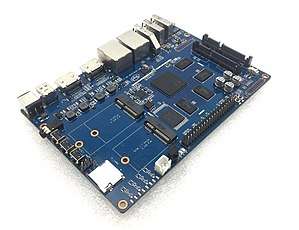 | |
| Developer | [ Banana Pi] |
|---|---|
| Type | Single-board computer |
| Release date | 2018 |
| Operating system | Android (Android 5.1), Linux (Bananian, OpenWrt and others) |
| System-on-chip used | Realtek RTD1296 |
| CPU | ARM Cortex-A53 Quad-core (ARMv8-A) up to 64 bit |
| Memory | 2 GB |
| Storage | eMMC, MicroSD card & SATA 3.0 (6Gbps, 1 or optionally 2 ports) |
| Graphics | Mali-T820 MP3[3] |
| Dimensions | 148 mm × 100.5 mm |
| Weight | 100 g |
Banana PI BPI-W2 is a highly integrated multimedia network router;it can be used for high wireless performance, home entertainment, home automation, etc.
BPI-W2 integrate a Quad-core ARM Cortex-A53 MPcore operating up to 1.5 GHz, The Router also includes a variety of peripherals, including HDMI RX/TX, Mini DP, PCIe2.0,PCIe1.1&SDIO,M.2 interface, USB2.0, USB3.0 Port, SATA port,2 Gbit/s Port Gigabit Ethernet port, also support 802.11ac/n WLAN connection thru PCI-e port.
BPI-W2 can run with Android6.0 smoothly, it also can run OpenWRT, Debian, Raspbian and other OS. The size of Banana Pi BPI-W2 same as BPI-R2, it can easily run with 1080P high definition video output, the GPIO is compatible with Raspberry Pi 3.
| HardWare Specification of Banana pi BPI-W2 | |||
| Soc | Realtek RTD1296 quad-core ARM A53 | ||
| GPU | Mali T820 MP3 GPU | ||
| SDRAM | 2GB DDR4 \(shared with GPU\) | ||
| Power | 12V @ 2A via DC power | ||
| Low-level peripherals | 40 Pins Header, 28×GPIO, some of which can be used for specific functions including UART, I2C, SPI, PWM, I2S. | ||
| Onboard Network | 2x 10/100/1000Mbit/s Ethernet | ||
| Wifi/Bluetooth | **Option** ,not support onboard WIFI & BT | ||
| RGMII | 1 RGMII interface with PIN | ||
| On board Storage | MicroSD \(TF\) card; 2 native SATA 3 6Gbit/s ;eMMC;SIM card slot | ||
| Display | HDMI \(Type A\) output with HDCP 1.4, resolutions up 1920x1200; MIPI DP | ||
| Video
decoder/encoder |
The Video DSP of RTD1296 is dedicated to manipulating,decoding and encoding of video streams in various formats, e.g. decoding 4K2K H.265,Full HD MPEG1/2/4/H.264/H.264 MVC,AVC/VC-1,VP8,AVS,AVS Plus,HD jpeg,etc.Video decoding and encoding can run simultaneously. support 3D de-intrlacing,video scaling up to 4K2K and so on. | ||
| Audio decoding | Audio decoding is carried out by an Audio DSP that is capable of decoding a set of audio formats,e.g. DTS HD,Dolby Digital Plus,TrueHD,and other popular formats.the Audio DSP also performs audio post processing | ||
| Audio input / output | supports two audio device HDMI and headphone, also support Audio In/Out with PIN define. support 2 MIC in | ||
| HDMI Out/In | 1* HDMI 2.0a out port and 1* HDMI 2.0a In port | ||
| Audio outputs/Inputs | HDMI, I2S audio,Audio micro out, Audio out/in with PIN define | ||
| M.2 KEY E:PCIE 2.0/USB 2.0 | 1 pcie 2.0 interface | ||
| M.2 KEY E:PCIe 1.1 / SDIO / USB 2.0 | 1 pcie 1.1 and SDIO interface | ||
| USB 3.0 | 1x USB 3.0 host | ||
| USB 2.0 | 2x USB 2.0 OTG, 1 with standard USB port, 1 define with PIN | ||
| M.2 KEY B | 1 * M.2 interface USB 2.0 for 4G with Micro SIM card slot | ||
| Mini DP | 1* Mini DP | ||
| TYPE C | 1 type C interface | ||
| RTC battery | RTC battery power interface | ||
| Buttons | Reset button, Power button, U-boot button | ||
| Leds | Red, Green, Blue | ||
| Other | IR receiver | ||
| Sizes | 148 mm × 100.5mm | ||
| Weight | 100g | ||
Note:
- The Banana Pi w2 Board BPI wiki page : Banana Pi BPI-W2 wiki Page
Banana Pi BPI-D1
 Banana Pi single board computer | |
| Developer | Banana Pi |
|---|---|
| Type | Single-board computer |
| Release date | October 2014 |
| Operating system | running on Linux 3.4.35 |
| CPU | ARM986EJ 32Bits RISC Core 400 MHz |
| Memory | 64MB DDR2 |
| Storage | MicroSD card |
| Dimensions | 38 mm × 38 mm |
| Weight | 10 g |
The BPI-D1 is one of the smallest open-source development boards currently on the market, with a built-in HD mini camera. At 36mm (w) x36mm (l) and weighing in at 10g, it is claimed to be much smaller than other boards with comparable features. The board is specially suited to mini-cam applications, providing high-resolution image quality: both video and still capture at 1280x720p with a video capture rate of 30 fps.

The Banana Pi-D1 is designed to provide a set of multimedia tools in one small package, that can be run from an external battery source.
The major features of the D1 include: HD mini-cam, audio sensor, microphone, CPU, GPIO, and Wi-Fi,
Note:
- The Banana Pi D1 Board detailed document on Banana Pi D1 Gitbook Page
Banana Pi BPI-G1
Banana Pi-G1 is an integrated IEEE 802.11 b/g/n (Wi-Fi wireless network), IEEE 802.15.4 (Zigbee), IEEE 802.11-2007 Standard (Bluetooth Low Energy 4.0) development board. All three wireless protocols can be used together, you can exchange any different transport protocols, and each wireless protocol is supported by its own single-chip SOC, which can facilitate Internet of Things (IoT) projects.
The Wi-Fi uses TI CC3200, which is a high-performance ARM Cortex-M4 wireless SOC, internally integrated TCP/IP protocol stack. This allows simple connection to the Internet using the BSD Socket.
The Zigbee uses TI CC2530, which integrates wireless capabilities and enhanced 8051 core SOC. After years of improvement, it is quite mature and stable. TI's Z-stack has achieved Zigbee 2007/Pro, you can use the 16's short address, you can use the 64-bit long address communication, face large local interconnect systems, providing advanced security encryption and mesh network structure support.
The Bluetooth 4.0 (BLE) uses TI CC2540/1, an integrated BLE stack and enhanced 8051 core, low-power wireless SOC. At present, most mobile phones have support for Bluetooth 4.0, both as a wearable device, or mobile interactive accessories, CC2540 can be easily completed. Meanwhile, BPI G1 also incorporates a high-performance STM32 ARM Cortex-M3 microcontroller, which help in dealing with time-consuming data or transit, the three wireless SOC coordinated.
Therefore, the Banana Pi G1 support a wide range of Internet of Things DIY wireless projects.
 Banana Pi single board computer | |
| Developer | Banana Pi |
|---|---|
| Type | Single-board computer |
| Release date | April 2015 |
| Operating system | Free-RTOS, TI-OS, Coutom-OS |
| System-on-chip used | STM32F103 |
| Dimensions | 95 mm × 56 mm |
| Weight | 19 g |
| Banana Pi G1 | |
|---|---|
| MCU | STM32F103CB ARM Cortex™ -M3 32-bit RISC core |
| Wi-Fi | TI CC3200 integrated ARM Cortex-M4 MCU with Wi-Fi network cc 3200 device is an integrated high-performance ARM Cortex-M4 MCU and with a Wi-Fi network processor subsystem (This subsystem includes 802.11 b/g/n radio, baseband, network protocol stack, a powerful encryption engine MAC, supports 256 bit encryption in order to achieve a fast, secure Internet connection). This device contains a variety of peripherals, including a fast parallel camera interface, I2S, Secure Digital/MultiMediaCard, UART, SPI, I2C, and four-channel analog to digital converter (ADC). |
| Bluetooth | TI CC2540 device is a low cost, low power, true system-on-chip (SoC) for Bluetooth low energy applications. It enables to build a strong BLE master or slave node with low total BOM cost. |
| ZigBee | IEEE802.15.4 via TI CC2530 (SoC) for IEEE 802.15.4, Zigbee RF4CE applications and solutions. CC2530 combines an excellent RF transceiver, industry-standard enhanced 8051 MCU, in-system programmable flash memory, 8 KB RAM, outstanding performance, and many other powerful features. |
| Power Source | 5V DC |
| Buttons | reset |
| LED | Wi-Fi Bluetooth ZigBee |
| Display | OLED(128*64) |
| OS | Free-RTOS Ti-OS Custom-OS |
Note:
- The Banana Pi G1 Board detailed document on Banana Pi G1 Gitbook Page
Powered by AXP209 power management unit, Banana Pi is able to output up to 1.6A, which means users can drive an external HDD without an extra power supply.
The Banana Pi board is similar to Cubieboard2.[14]
Banana Pi BPI-M2
 Banana Pi-M2 single board computer | |
| Developer | Banana Pi |
|---|---|
| Type | Single-board computer |
| Release date | April 2015 |
| Operating system | Android (Android 4.2, Android 4.4),Linux (Bananian, Lubuntu, Raspbian, Debian GNU/Linux, Fedora, Arch Linux ARM, Gentoo, openSUSE), Berryboot, FreeBSD, OpenWrt |
| System-on-chip used | Allwinner A31[15] |
| CPU | ARM Cortex-A7 Quad-core (ARMv7-A) 1 GHz |
| Memory | 1 GB |
| Storage | MicroSD |
| Dimensions | 92 mm × 60 mm |
| Weight | 52 g |
The Banana Pi M2 (BPI-M2) is a credit card-sized and low-power single-board computer. It is a quad core version of Banana Pi, and supports on board Wi-Fi. The Banana Pi M2 series runs Android, Debian, Ubuntu, Raspberry Pi images and other images.
Banana PI M2 hardware: 1Ghz ARM7 quad-core processor, 1GB DDR3 SDRAM, Gigabit ethernet port.
The Banana PI M2 is the same size as the Banana Pi M1. It supports 1080P high definition video output, and the GPIO is compatible with Raspberry Pi B+.
| Banana Pi M2 | |
|---|---|
| CPU | A31S ARM Cortex-A7 Quad-Core, 256K[2] B L1 cache 1MB L2 cache |
| GPU | PowerVR SGX544MP2 Comply with OpenGL ES 2.0 OpenCL 1x,DX9_3 |
| Memory | 1GB DDR3 (shared with GPU) |
| Network | 10/100/1000 Ethernet 8P8C, Wi-Fi |
| Video Input | A CSI input connector allows for the connection of a designed camera module |
| Video Outputs | HDMI, LVDS/RGB |
| Audio Outputs | 3.5mm jack and HDMI |
| Power Source | 5 volt via Micro USB(DC in Only)and /or Micro USB OTG |
| USB 2.0 ports | 4 USB PORT |
| GPIO | GPIO, UART, I2C BUS, SPI BUS, WITH TWO CHIP SELECTS, ADC, PWM, +3.3V, +5V, GND |
| LED | Power Key & 8P8C |
| OS | Android and Linux etc.OS |
Note:
- Since June 2017, BPI-M2 is the first product that stopped production in Banana PI series. Allwinner A31S chip stopped production since 2016, and the company ran out of stock of the chip.
- The Banana Pi M2 Board detailed document on Banana Pi M2 Gitbook Page
Banana Pi Pro
 | |
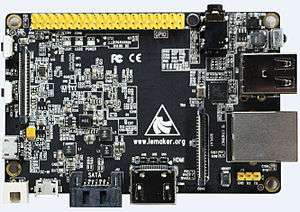 Banana Pi single board computer | |
| Developer | Banana Pi |
|---|---|
| Type | Single-board computer |
| Release date | October 2014 |
| Operating system | Android (Android 4.2, Android 4.4),Linux (Bananian, Lubuntu, Raspbian, Debian GNU/Linux, Fedora, Arch Linux ARM, Gentoo, openSUSE), Berryboot, FreeBSD, OpenWrt |
| System-on-chip used | Allwinner A20[8] |
| CPU | ARM Cortex-A7 Dual-core (ARMv7-A) 1 GHz |
| Memory | 1 GB |
| Storage | MicroSD card & SATA 2.0 |
| Graphics | Mali-400 MP2[3] |
| Dimensions | 92 mm × 60 mm |
| Weight | 48 g |
The Banana Pi Pro is a credit card-sized and low-power single-board computer developed in China by the LeMaker Team, with the goal of promoting STEM (science, technology, engineering and mathematics) education in schools.
Like its smaller sibling the Banana Pi, the Pro concept is heavily influenced by the Raspberry Pi, however the Banana Pro provides various enhancements over prior designs.
The Banana Pro has an Allwinner A20 system on a chip (SoC), which includes an ARM Cortex-A7 Dual-core (ARMv7-A) 1 GHz, Mali-400 MP2 GPU and 1GB DDR3 SDRAM.
The Banana Pro uses a microSD card for booting an OS, but also includes a SATA 2.0 interface to allow connection of a hard disk for additional storage, however you cannot boot from the hard disk.
Other differences from the Banana Pi include on-board Wi-Fi 802.11 b/g/n AP6181, integrated composite video and audio output into a 3.5 mm TRRS jack. This makes space for a 40-pin extension header.
Specifications
| Banana Pi[16] | Banana Pro[17] | |
|---|---|---|
| SoC | Allwinner A20 | Allwinner A20 (CPU, GPU, SATA 2.0, 3 USB ports) |
| CPU | 1 GHz ARM Cortex-A7 Dual-core | 1 GHz ARM Cortex-A7 Dual-core (ARMv7 instruction set) |
| GPU | ARM Mali-400 MP2 dual GPU core | Mali-400 MP2 - complies with OpenGL ES 2.0/1.1 (hardware acceleration support) |
| Memory (SDRAM) | 1 GB DDR3 DRAM (shared with GPU) | 1 GB DDR3 DRAM (shared with GPU) |
| Power | Expects 5 V source connected to the micro-USB connector, recommended 2 A if connecting a SATA hard disk using the onboard power connector | 5 V @ 2 A via micro-USB (DC in only) and/or micro-USB (OTG) |
| PMU | AXP209 | |
| USB | 2 USB 2.0 host, 1 USB OTG | 2 USB 2.0 host, 1 USB 2.0 OTG (all direct from A20 chip) |
| Low-level peripherals | 26 extended pins including I²C, SPI, UART, CAN bus | 40 pins GPIO headers
28 GPIO, some of which can be used for specific functions including UART, I2C, SPI, PWM, CAN, I2S, SPDIF |
| Onboard Storage | SD slot (maximum 64 GB), 7-pin SATA 2.0 data port (with a separate power connector), supporting maximum 4 TB hard drive | MicroSD card
SATA 2.0 (with a separate power connector) |
| Onboard Network | 10/100/1000 Ethernet connector, with LEDs | 10/100/1000 Ethernet 8P8C,
65 Mbit/s Wi-Fi 802.11 b/g/n AP6212 |
| Bluetooth | Optional | |
| Display | Allwinner A20 built-in, supports HDMI 1080p and CVBS | Supports multi-channel HD display:
HDMI 1.4 (Type A - full), composite video (PAL and NTSC) (via 3.5 mm TRRS jack shared with audio out), LVDS/RGB/CPU display interface (DSI) for raw LCD panels. 11 HDMI resolutions from 640×480 to 1920×1080 plus various PAL and NTSC standards |
| Video | CedarX | HD H.264 2160p video decoding. Multi-format FHD video decoding, including MPEG1/2, MPEG4, H.263, H.264, etc. H.264 high-profile 1080p@30fps or 720p@60fps encoding |
| Camera | 1 CSI camera connector | Parallel 8-bit camera interface |
| Audio Outputs | ⌀3.5 mm audio output jack | HDMI, analog audio (via 3.5 mm TRRS jack shared with composite video out), I2S audio (also potentially for audio input) |
| Audio input | Onboard microphone | Onboard microphone |
| Buttons | Power, reset and u-boot switches mounted on board | Power, reset and u-boot switches mounted on board |
| LEDs | One user-defined LED on board | Power status LED (red), Ethernet status LED (blue), user defined LED (green) |
| Other | Onboard IR receiver | Onboard IR receiver |
| Dimensions | 92 mm × 60 mm | 92 mm × 60 mm |
| Weight | 48 g | 48 g |
Available operating systems
Banana Pi[17]
- Android 4.2.2 & 4.4 for Banana Pi (Linux kernel 3.4.39+, 4.4 doesn't support Wi-Fi and has many bugs, 4.2.2 doesn't support all apps in Korea)
- Archlinux for Banana Pi (Linux kernel 3.4.103; 2014-12-26)
- Armbian stable, with more kernel options, Debian or Ubuntu userland (3.4.113, 4.9.7, 4.11.0; 5.5.2017)
- Bananian Linux (Debian based; Linux kernel 3.4.111; 2016-04-23)
- CentOS 7 (1511)
- Fedora for Banana Pi (Linux kernel 3.4.103; 2014-12-26)
- Kali Linux for Banana Pi (Linux kernel 3.4.103)
- Kano for Banana Pi (Linux kernel 3.4.103)
- Lubuntu for Banana Pi (Linux kernel 3.4.103; 2014-12-26)
- NetBSD 7.0
- OpenMediaVault[18]
- OpenWrt[19]
- openSUSE for Banana Pi (openSUSE v1412; Linux kernel 3.4.103; 2014-12-26)
- Raspbian for Banana Pi (Linux kernel 3.4.103; 2014-12-26)
- ROKOS for Banana Pi (Linux kernel 3.4.103; 2014-12-26)
- Scratch for Banana Pi (Boot to Scratch directly) (Linux kernel 3.4.103)
See also
References
- ↑ "Debian Wiki: armhf – Arm Hard Float Port". Debian Wiki.
- 1 2 "A20_Allwinner Technology". Allwinnertech.com. 2013-04-23. Retrieved 2016-07-12.
- 1 2 3 4 5 6 7 8 "Mali-400". ARM. Retrieved 2016-07-12.
- ↑ Heath, Nick (21 May 2014). "Raspberry Pi: Five alternatives for hackers and modders". TechRepublic.
- ↑ Halfacree, Gareth. "Banana Pi review – tastier than Raspberry?". Linux User & Developer.
- ↑ Brown, Eric (24 April 2014). "Raspberry Pi Clones Match the Connectors, But Boost the Firepower". Linux News.
- ↑ "H3_Allwinner Technology". Allwinnertech.com. 2013-04-23. Retrieved 2016-07-12.
- 1 2 3 4 "H2+_Allwinner Technology". Allwinnertech.com. 2013-04-23. Retrieved 2016-07-12.
- ↑ "R40_Allwinner Technology". Allwinnertech.com. 2016-01-01. Retrieved 2016-10-27.
- ↑ "Banana Pi BPI-M2 Berry Allwinner V40 Development Board, Allwinner Business Units & SDK/Software Management". CNXSoft. 29 May 2017. Retrieved 2 March 2018.
- ↑ "R16_Allwinner Technology". Allwinnertech.com. 2017-02-26. Retrieved 2017-02-26.
- ↑ "A80_Allwinner Technology". Allwinnertech.com. 2013-04-23. Retrieved 2016-07-12.
- 1 2 forum.banana-pi.org The M3 has no SATA support, its USB-to-SATA bridge is many times slower than the native SATA implementation of M1/M1+
- ↑ "Test: Einplatinen-Computer Banana Pi als Raspberry-Pi-Ersatz". CT Magazine (in German).
- ↑ "A31_Allwinner Technology". Allwinnertech.com. 2013-04-23. Retrieved 2016-07-12.
- ↑ "Banana Pi Specifications". Lemaker Wiki.
- 1 2 "Specifications from board manufacturer". Banana Pro.
- ↑ http://www.lemaker.org/product-bananapro-resource.html
- ↑ http://www.lemaker.org/product-bananapi-resource.html